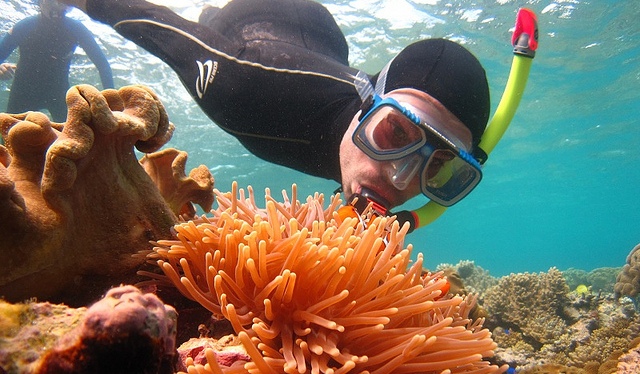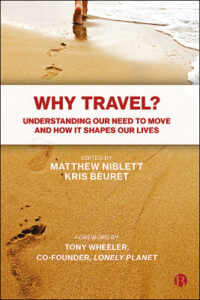The Ethical Paradox of Last Chance Tourism
Is the rush to visit places before they disappear actually hastening their demise?

Amid fears of irreversible coral bleaching, an increasing number of tourists want to see the Great Barrier Reef ‘before it’s too late’. Image: Paul Arps, Diving for Nemo (Australia 2010), licensed under Creative Commons via flickr.
15th November 2016
The Great Barrier Reef was in the headlines this summer as researchers found the reef was experiencing the highest level of coral bleaching on record. UNESCO included the Great Barrier Reef in a draft report on tourist destinations at risk from climate change [1] and celebrities such as Ellen DeGeneres urged the Australian government to protect this unique and increasingly threatened ecosystem. Concerned about the effects of an “in danger” UNESCO listing on the reef’s US$5.2 billion tourist industry,[2] the Australian government is reported to have requested that UNESCO remove all mention of the Great Barrier Reef from its report, in return for assurances that Australia would do more to protect the reef and cut damaging agricultural runoff by 80% in the next 10 years.[3]
Although the Australian government is concerned that an ‘in danger’ listing will reduce tourism, a recent survey found that one of the main motivations for many tourists visiting the reef is its threatened nature and therefore they want to see it ‘before it is too late’.[4] This desire of tourists to seek out vanishing places, species or cultures has been termed ‘Last Chance Tourism’ (LCT), and is recognised as a trend of increasing importance within tourism. Other popular ‘last chance’ destinations include the Polar Regions and habitats for mountain apes in central Africa.
Interestingly, the same survey found that those visitors to the Great Barrier Reef who were seeking a ‘last chance’ experience were also more likely to be aware of and concerned about the ecological health of the reef and about environmental issues in general (such as climate change). At the same time they did not consider their activities as tourists (such as contributing to carbon emissions through their travel) to be linked to damaging effects on the environment. In the case of coral, carbon emissions could have a doubly damaging effect by contributing to higher sea temperatures and lowering the pH of the ocean.
Such results support the concerns of some academics and environmentalists that Last Chance Tourism could be having a negative impact on destinations both directly and through increased carbon emissions, and that these ‘last chance tourists’ are in fact accelerating the destruction of the places they set out to see. However, work by academics looking at a number of LCT destinations across the world has also found examples of the positive impact that such tourism can have.[5] If carefully managed the research indicates that the negative consequences of tourist visits can be lowered and the income from tourism channelled to good conservation practices, as seen, for example, with mountain gorilla tourism in Rwanda. And the direct personal experience of being in a place or seeing certain species has been found by researchers to produce “an emotional bond, where individuals learn and want to help by becoming last chance to see ambassadors.” LCT can thus be “a call to action… an opportunity to learn and possibly reverse these changes before it is too late.”[6]
Since tourist visits to these fragile destinations can have a large impact, both positive and negative, it is important to understand the motivation behind this desire to participate in Last Chance Tourism. The lexicon of tourists and travellers abounds with lists for collection: the phrase ‘see it before it disappears’ has been added to ‘must see lists’ and ‘bucket lists’. The collection of places and experiences can be displayed to others via photographs, souvenirs, and writings, even more so in the age of the internet and social media, and such displays play a role in the traveller’s social status and image of themselves. Theorists of tourism have long discussed the enduring appeal of rarity and how “the acquisition, consumption, and/or ownership of these rare products conveys social prestige and status.”[7] Last Chance Tourism can be understood as a part of this desire to collect rarity, as well as an urge to learn more about parts of our world that are at risk and to try to help in saving them.
Last Chance Tourism at the Great Barrier Reef highlights the important economic, environmental and ethical issues surrounding our travel choices. These issues are a central concern to the Independent Transport Commission’s Why Travel? project, which aims to better understand why we travel in the ways that we do, and how we might improve the decisions we make about travel. Integrating perspectives from across the sciences, arts and humanities, the project looks to the past, present and future of human travel. For more information on our research as well as regular news items and talks from travel experts, please see our website www.whytravel.org
[1] The UNESCO 2016 World Heritage in a Changing Climate Report http://whc.unesco.org/en/activities/883/
[2] https://www.theguardian.com/environment/2016/may/07/great-barrier-reef-tourism-operators-urge-australian-government-to-tackle-climate-change
[3] https://www.yahoo.com/news/last-chance-tourism-adding-great-barrier-reef-woes-130058189.html
[4] http://www.tandfonline.com/doi/full/10.1080/09669582.2016.1213849
[5] In their book Last Chance Tourism (2012), editors Lemelin, Stewart and Dawson “discovered more positive developments than expected. Many of the case studies in this book are reasons for hope, not despair… From this perspective, last chance tourism pays homage to biodiversity and conservationism.” http://documents.routledge-interactive.s3.amazonaws.com/9781138784567/Ch%2012_Lemelin.pdf
[6] ibid
[7] ibid


